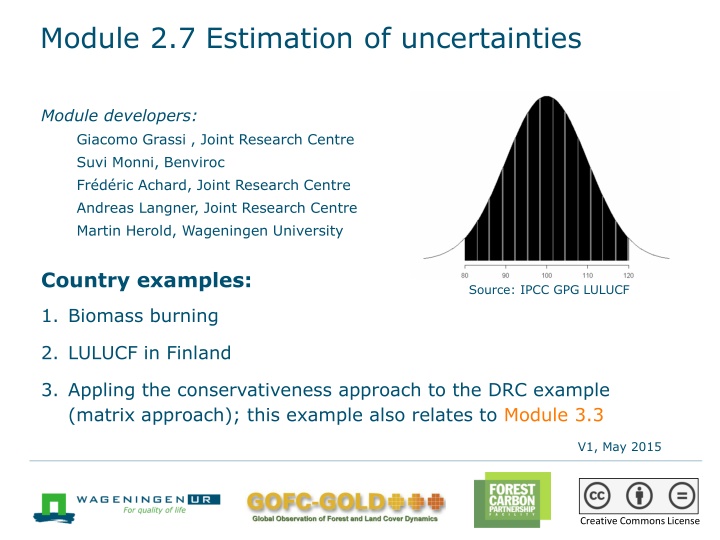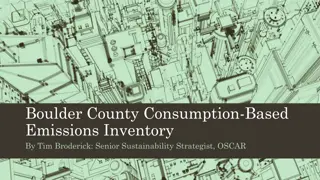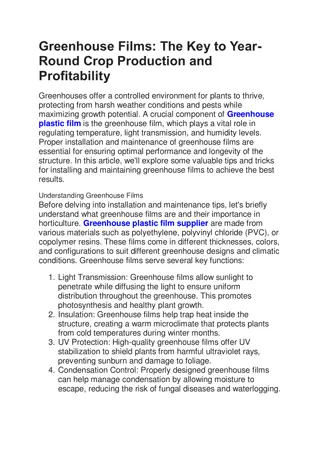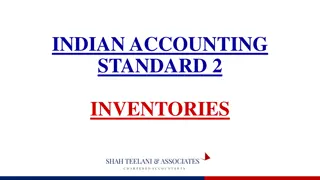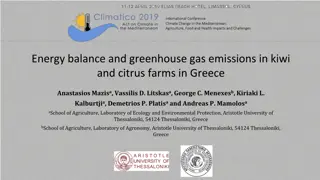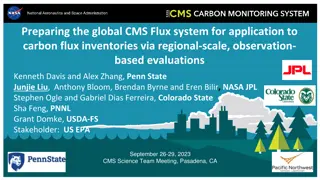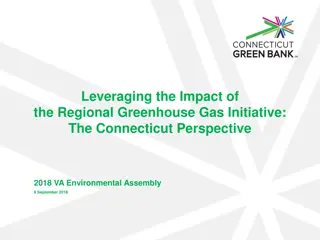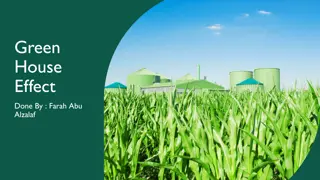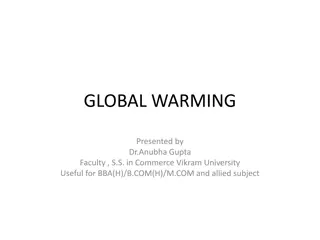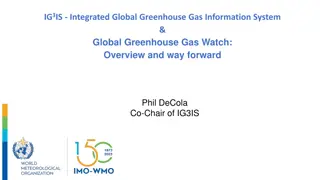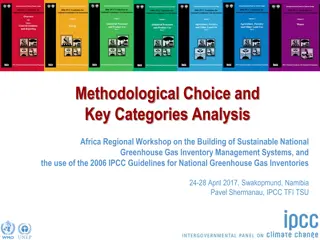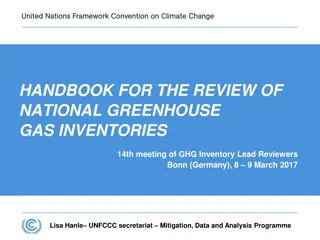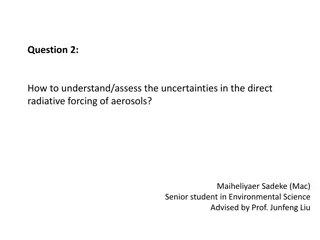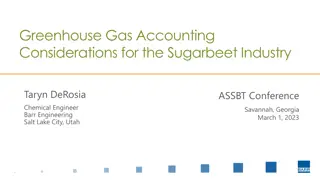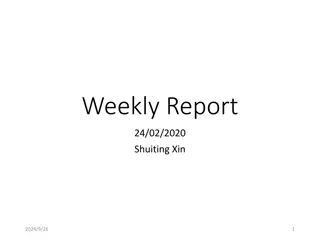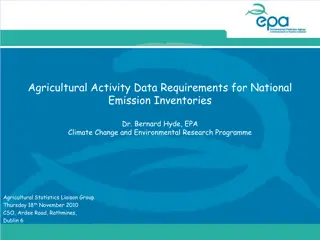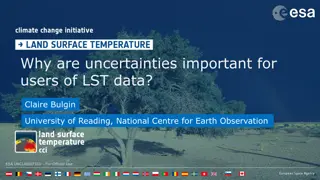Estimation of Uncertainties in Greenhouse Gas Inventories: Examples and Analysis
This module explores the estimation of uncertainties in greenhouse gas inventories with examples from biomass burning and LULUCF in Finland. It covers approaches, data used, calculations, and contributions to overall uncertainties. The examples illustrate the complexity and significance of uncertainty analysis in environmental assessments.
Download Presentation

Please find below an Image/Link to download the presentation.
The content on the website is provided AS IS for your information and personal use only. It may not be sold, licensed, or shared on other websites without obtaining consent from the author.If you encounter any issues during the download, it is possible that the publisher has removed the file from their server.
You are allowed to download the files provided on this website for personal or commercial use, subject to the condition that they are used lawfully. All files are the property of their respective owners.
The content on the website is provided AS IS for your information and personal use only. It may not be sold, licensed, or shared on other websites without obtaining consent from the author.
E N D
Presentation Transcript
Module 2.7 Estimation of uncertainties Module developers: Giacomo Grassi , Joint Research Centre Suvi Monni, Benviroc Fr d ric Achard, Joint Research Centre Andreas Langner, Joint Research Centre Martin Herold, Wageningen University Country examples: Source: IPCC GPG LULUCF 1. Biomass burning 2. LULUCF in Finland 3. Appling the conservativeness approach to the DRC example (matrix approach); this example also relates to Module 3.3 V1, May 2015 1 Module 2.7 Estimation of uncertainties REDD+ training materials by GOFC-GOLD, Wageningen University, World Bank FCPF Creative Commons License
Example 1: Biomass burning (1/2) This country example shows a combination of uncertainties for non-CO2emissions from biomass burning for an Annex I party. Note that no uncertainty is assumed for GWP values. The table below shows the data used in the calculations. Value 1.16 kha 43 Mg CH4/kha 0.3 Mg N2O/kha Uncertainty 10% 70% 70% GWP value Area burned CH4EF N2O EF 21 310 2 Module 2.7 Estimation of uncertainties REDD+ training materials by GOFC-GOLD, Wageningen University, World Bank FCPF
Example 1: Biomass burning (2/2) ??4????????? = 1.16 ? ? 43????4 ??????????? ?? ??4????????? = ?2? ????????? = 1.16 ? ? 0.3 310 = 107.88 ????2?? ??????????? ?? ?2? ????????? = ????? ????????? = 1047.48?? ??2?? + 107.88?? ??2?? = 1155.36 ?? ??2?? ??????????? ?? ????? ????????? = 21 = 1047.48 ?? ??2?? ? ? 10%2+ 70%2= 70.7% 10%2+ 70%2= 70.7% 70.7% 1047.482+ 70.7% 107.882 1047.48+107.88 = 64.4% 3 Module 2.7 Estimation of uncertainties REDD+ training materials by GOFC-GOLD, Wageningen University, World Bank FCPF
Example 2: LULUCF in Finland (1/3)* For its GHG inventory, Finland carries out Tier 1 uncertainty analysis annually and a Tier 2 analysis periodically. The uncertainty of KP LULUCF accounting is 37%, with contributions of FM ( 32%), AR ( 225%), and D ( 73%). In the national GHG inventory, LULUCF contribution is significant: Table: Inventory uncertainties * Synthesis from the National Inventory Report of Finland (Statistics Finland 2013). 4 Module 2.7 Estimation of uncertainties REDD+ training materials by GOFC-GOLD, Wageningen University, World Bank FCPF
Example 2: LULUCF in Finland (2/3) For forest land remaining forest land, uncertainty analysis is done by pools: living biomass, mineral, and organic soils. Both sampling uncertainty of national forest inventory (NFI) and model uncertainty (used for reporting) are considered. For living biomass, the gain-loss method is applied, which requires data regarding increment and losses: Uncertainty (U%) includes sampling of volume increment (4-13%), BCEF (0.5-2.5%), losses by felling (2 5%), natural losses (15%), model (5%) total U% of 16% U% for mineral soils (24%) estimated by Yasso07 model Total U% of C stock changes estimated at 34% 5 Module 2.7 Estimation of uncertainties REDD+ training materials by GOFC-GOLD, Wageningen University, World Bank FCPF
Example 2: LULUCF in Finland (3/3) Conversion to/from forest land and related KP activities: estimation of C stock change in all pools is done by: AD x EF. Uncertainty of AD due to sampling was estimated from NFI: Because of small land areas involved, a high sampling error is reported: e.g., U% for deforestation is 30% U% in the increment of living biomass and in the mineral and organic soil emission factors is based on expert judgement. For emissions from soils under conversions of forest land to cropland and grassland, preliminary estimates are 60 150%. 6 Module 2.7 Estimation of uncertainties REDD+ training materials by GOFC-GOLD, Wageningen University, World Bank FCPF
Example 3: Appling the conservativeness approach to the Democratic Republic of Congo (DRC) example (matrix approach) (1/14) (This example also relates to exercise 4 and Module 3.3) IPCC basics to estimate forest C stock changes Emissions = activity data (AD) x emission factor (EF) Six land uses: forest land, cropland, grassland, wetlands, settlements, other lands Methods to estimate C stock changes: Gain-loss: growth minus harvest minus other losses (all tiers) Stock change: difference of C stock over time (only Tiers 2 3) IPCC would require Tier 2/3 methods for EF in "Key Categories" (likely including deforestation and degradation in most cases), but most developing countries are not ready yet for Tier 2/3. 7 Module 2.7 Estimation of uncertainties REDD+ training materials by GOFC-GOLD, Wageningen University, World Bank FCPF
Example 3: REDD+ matrix (2/14) How would REDD+ activities fit into IPCC land uses? To Forest land Other land From Forest land Forest degradation Forest conservation Sustainable management of forests Enhancement of carbon stocks Deforestation Other land Enhancement of carbon stocks (Afforestation/ Reforestation) Stock change method: C before minus C after Gain-loss: growth minus harvest minus other losses Difficult to get data IPCC (very uncertain) FAOSTAT: very difficult to get the right data! Overall, unlikely to estimate C stock changes from degradation with tier 1 8 Module 2.7 Estimation of uncertainties REDD+ training materials by GOFC-GOLD, Wageningen University, World Bank FCPF
Example 3: REDD+ matrix (3/14) Don t forget degradation! Estimates of carbon emissions from degradation (expressed as an additional percentage to the emissions from deforestation) Additional emissions due to forest degradation Humid tropics +6% Brazilian Amazon, Peruvian region Tropical regions +29% Study area Reference Achard et al. 2004 +25-47% Asner et al. 2005 Houghton 2003 Houghton and Hackler 1999 Gaston et al. 1998 South East Asia +25-42% Tropical Africa +132% 9 Module 2.7 Estimation of uncertainties REDD+ training materials by GOFC-GOLD, Wageningen University, World Bank FCPF
Example 3: REDD+ matrix (4/14) Modified IPCC land transition matrix (REDD+ matrix) To Forest land Other land Intact (natural) forest Non intact forest From Intact (natural) forest Forest degradation Forest conservation Deforestation Forest land Enhancement of C stocks (forest restoration) Sustainable management of forests Enhancement of C stocks (A/R) Non intact forest Deforestation Other land - Stock change method: C before C after Gain-loss: growth harvest other losses 10 Module 2.7 Estimation of uncertainties REDD+ training materials by GOFC-GOLD, Wageningen University, World Bank FCPF
Example 3: REDD+ matrix (5/14) How to identify non intact forests? Among different possible approaches, forest edges may be used as a simple and pragmatic proxy to identify non intact areas (boundary forests), or at least may be a first step to be complemented by other more accurate approaches (i.e., high-resolution remote sensing). The underlying assumption is that forests that are sufficiently remote from nonforested areas (i.e., at a certain distance from roads, navigable waters, crops, grasslands, mines, etc.) are protected against significant anthropogenic degradation. 11 Module 2.7 Estimation of uncertainties REDD+ training materials by GOFC-GOLD, Wageningen University, World Bank FCPF
Example 3: REDD+ matrix (6/14) Example of identification of boundary forests Input: binary forest maps using the methodology of FAO Remote Sensing Survey Intensified sampling 60x60 m Treatment: morphological spatial pattern analysis (MSPA) Biome specific: rainforest in Congo Basin (Edge size=500m) Could as well be called exposed, potentially degraded, managed, or simply other forests. 12 Module 2.7 Estimation of uncertainties REDD+ training materials by GOFC-GOLD, Wageningen University, World Bank FCPF
Example 3: REDD+ matrix (7/14) Case study in DRC Area transition matrices for a biome: Congo rainforests (ha 000s) a. 2000 2005 b. 2005 2010 NFL 2005 BFL 2005 Total 2000 NFL 2010 BFL 2010 total 2005 OL 2005 OL 2010 NFL 2000 NFL 2005 78,424 828 26 79,278 76,950 1407 66 78,424 BFL 2000 BFL 2005 - 24,747 316 25,063 - 24,976 599 25,575 OL 2000 0 - 123,839 123,839 OL 2005 0 - 124,182 124,181 Total 2005 Total 2010 78,424 25,575 124,181 228,180 76,950 26,383 124,847 228,180 NFL = natural forest land; BFL = boundary forest; OL = other land. 13 Module 2.7 Estimation of uncertainties REDD+ training materials by GOFC-GOLD, Wageningen University, World Bank FCPF
Example 3: REDD+ matrix (8/14) Area-based hypothetical reference level Sust. mgd. forests Deforestation (in 5 yrs) Degraded (in 5 yrs) Conser- vation Total NFL to OL EFL to OL NFL to EFL EFL to EFL NFL to NFL 26 316 828 24,747 78,424 228,180 Historical 2000-2005 +100% = 52 66 +100% = 632 599 +100% = 1,656 Area (103 ha) 24943 76,716 228,180 Ref. level 2005-2010 1,407 24,976 76,950 228,180 Actual 2005-2010 Difference actual - RL 27 125 -249 -125 221 0 NFL = natural forest land; BFL = boundary forest; OL = other land 14 Module 2.7 Estimation of uncertainties REDD+ training materials by GOFC-GOLD, Wageningen University, World Bank FCPF
Example 3: REDD+ matrix (9/14) Estimating C stock changes for REDD activities Once the transition matrix for AD is done, each AD will need to be multiplied by the relevant EF to get C stock change for each REDD+ activity: For natural forest, Tier 1 EF are available from IPCC For boundary forests, data may be taken from the literature (or a crude assumption of half of C stock of NFL may be considered) Uncertainties values need to be associated with each EF. The proposed approach requires that the same Tier 1 EF (stratified by forest and climate type) be used in both reference level (RL) and in the accounting period. This means that the errors of EF in the RL and accounting period are fully correlated. 15 Module 2.7 Estimation of uncertainties REDD+ training materials by GOFC-GOLD, Wageningen University, World Bank FCPF
Example 3: REDD+ matrix (10/14) Sust. mgd. forests Deforestation (in 5 yrs) Degraded (in 5 yrs) Conservation Total NFL to OL EFL to OL NFL to EFL EFL to EFL NFL to NFL Area (103 ha) Difference actual - RL 15 -33 -249 -125 221 0 -150 -73 -78 C losses (-), tC/ha (a) (...) ( ) C increment (+), tC/ha/yr Cumulated credits(+) or debits (-) in 2010, MtC (b) -2,3 2,4 19,3 19.4 ( ) ( ) NFL = natural/intact forest land; BFL = boundary forest; OL = other land. (a) Assuming these values of biomass C stocks: NFL, 155 tC/ha (IPCC 2006); EFL, NFL/2 (or 50% degradation on average in exposed forests); OL, 5 tC/ha. (b) Calculated as the difference in area (actual minus RL) x the C stock change. 16 Module 2.7 Estimation of uncertainties REDD+ training materials by GOFC-GOLD, Wageningen University, World Bank FCPF
Example 3: REDD+ matrix (11/14) Taking uncertainties into account Assume that estimates for (accounting period minus RL) obtained with adequate methods for AD but not for EF (Tier 1) NFL 155 50 BFL 78 75 OL 5 50 Tier-1 C stocks (tC/ha) Uncertainty % (95%CI) NFL to OL 150 52 BFL to OL 73 80 NFL to BFL 78 125 Tier-1 C stock change (tC/ha) Uncertainty % (95%CI) When the uncertainties above are combined, total uncertainty of the emission reduction (19,4 Mt C) becomes >100% (95%CI) How to deal with the fact that this country used Tier 1 (highly uncertain) EF for a key category? see next slides 17 Module 2.7 Estimation of uncertainties REDD+ training materials by GOFC-GOLD, Wageningen University, World Bank FCPF
Example 3: REDD+ matrix (12/14) As part of the Kyoto Protocol review process, UNFCCC has approved conservativeness factors linked to specific uncertainty ranges. Essentially, these factors use the 50% confidence interval. 18 Module 2.7 Estimation of uncertainties REDD+ training materials by GOFC-GOLD, Wageningen University, World Bank FCPF
Example 3: REDD+ matrix (13/14) 50 Reduced emissions (M tC) 40 95% confidence interval 30 50% confidence interval 20 Lower bound of 50% CI ( 14MtC) 10 0 In this example, by discounting the emissions reduction by about 30% (following the approach of KP review), the risk of overestimating the reduction of emissions is significantly reduced. 19 Module 2.7 Estimation of uncertainties REDD+ training materials by GOFC-GOLD, Wageningen University, World Bank FCPF
Example 3: REDD+ matrix (14/14) In conclusion, the REDD+ matrix may allow one to estimate C stock change from deforestation/degradation based on IPCC Tier 1. The application of a conservative discount to address the high uncertainty of Tier 1 based estimates increases the credibility of any possible claim of result-based payment. The simplicity and cost-effectiveness of this approach may allow: Broadening the participation to REDD+, allowing those countries with limited forest monitoring capacity to join Increasing the credibility of emission reductions estimated with Tier 1, while maintaining strong incentives for further increasing the accuracy of the estimates, i.e., to move to higher tiers 20 Module 2.7 Estimation of uncertainties REDD+ training materials by GOFC-GOLD, Wageningen University, World Bank FCPF
Recommended modules as follow-up Module 2.8 to learn more about the role of evolving technologies for monitoring of forest area changes and changes in forest carbon stocks Modules 3.1 to 3.3 to proceed with REDD+ assessment and reporting 21 Module 2.7 Estimation of uncertainties REDD+ training materials by GOFC-GOLD, Wageningen University, World Bank FCPF
References Achard, F., Eva, H. D., Mayaux, P., Stibig, H.-J. and Belward, A., 2004. Improved estimates of net carbon emissions from land cover change in the tropics for the 1990s. Glob. Biogeochem. Cycles 18, GB2008. Asner, G. P., Knapp, D. E., Broadbent, E. N., Oliveira, P. J. C., Keller, M. and Silva, J. N., 2005. Selective logging in the Brazilian Amazon. Science 310, 480 2. Bucki, M., D. Cuypers, P. Mayaux, F. Achard, C. Estreguil, and G. Grassi. 2012. Assessing REDD+ Performance of Countries with Low Monitoring Capacities: The Matrix Approach. Environmental Research Letters 7 (1) 014031. Gaston, G., Brown, S., Lorenzini, M. and Singh, K. D., 1998. State and change in carbon pools in the forests of tropical Africa. Glob. Change Biol. 4, 97 114. Houghton, R. A., 2003. Revised estimates of the annual net flux of carbon to the atmosphere from changes in land use and land management 1850 2000. Tellus, B, 55, 378 90. 22 Module 2.7 Estimation of uncertainties REDD+ training materials by GOFC-GOLD, Wageningen University, World Bank FCPF
Houghton, R. A. and Hackler, J. L., 1999. Emissions of carbon from forestry and land-use change in tropical Asia. Glob. Change Biol. 5, 481 92. IPCC (Intergovernmental Panel on Climate Change). 2000. Good Practice Guidance and Uncertainty Management in National Greenhouse Gas Inventories. (Often IPCC GPG.) Geneva, Switzerland: IPCC. http://www.ipcc-nggip.iges.or.jp/public/gp/english/. IPCC, 2003. 2003 Good Practice Guidance for Land Use, Land-Use Change and Forestry, Prepared by the National Greenhouse Gas Inventories Programme, Penman, J., Gytarsky, M., Hiraishi, T., Krug, T., Kruger, D., Pipatti, R., Buendia, L., Miwa, K., Ngara, T., Tanabe, K., Wagner, F. (eds.). Published: IGES, Japan. http://www.ipcc- nggip.iges.or.jp/public/gpglulucf/gpglulucf.html (Often referred to as IPCC GPG) Statistics Finland. 2013. Greenhouse Gas Emissions in Finland, 1990 2011: National Inventory Report under the UNFCCC and the Kyoto Protocol. Helsinki: Statistics Finland. http://unfccc.int/national_reports/annex_i_ghg_inventories/national_inventories_submiss ions/items/7383.php. 23 Module 2.7 Estimation of uncertainties REDD+ training materials by GOFC-GOLD, Wageningen University, World Bank FCPF
